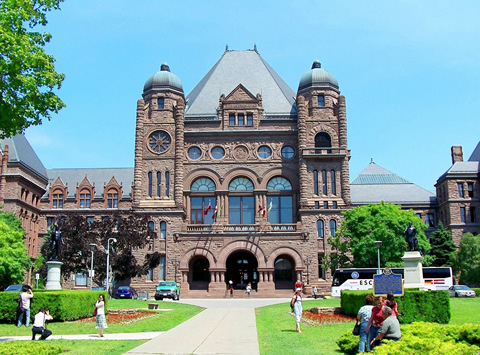Most Torontonians would probably agree that historic buildings such as Queen’s Park and Fort York are worth preserving. But what about views of those buildings? Should they be protected, too? Cathy Nasmith thinks so, and has been lobbying city officials for years to bring stricter safeguards into place.
It’s been a tough fight, and Nasmith (BArch 1978) recently lost an important battle. Over the last several months, she vocally opposed plans by the Four Seasons Hotel to construct a tower in Yorkville that’s half again as tall as its existing one. She says the skyscraper will be highly visible above Queen’s Park from University Avenue. And in her view, that’s architectural sacrilege.
“Queen’s Park is the seat of our democracy. It’s loaded with symbolic meaning. If a condo tower is visible behind it, then all of the symbolism of the grand approach up University Avenue to our democratic assembly becomes about the latest condo. It’s just not appropriate.”

Nasmith, a Toronto architect, says the city’s official plan recognizes such views as important, but includes no provisions to protect them. In this particular case, however, she blames the province for not stepping in, since Queen’s Park’s importance extends far beyond the city. “It’s appalling to say that it’s up to the city to protect a building of this cultural significance,” she says. “The city’s ability to do that is really hampered if the province isn’t on board.”
A founding member of the Friends of Fort York and a key player in the group that brought Doors Open to Canada, Nasmith publishes Built Heritage News, an online newsletter about preservation in Ontario that she sends to several hundred people every two weeks.
Nasmith’s interest in building heritage began when she was an architecture student at U of T in the 1970s. William Dendy, the author of Lost Toronto, a book about the city’s destroyed buildings from the 19th- and 20th-centuries, was one of her professors and a major influence. By 2000, when Nasmith became chair of the Toronto Preservation Board, heritage had become an important part of her architectural practice. “[Heritage protection] is not just about saving buildings with gingerbread on them,” she says. “It’s about a sense of the cultural value of architecture through the centuries. In the case of views, it’s about appreciating buildings in their settings.”
In theory, preserving heritage views has never been easier. John Danahy, a landscape architect professor at the John H. Daniels Faculty of Architecture, Landscape, and Design, says advanced computer modelling now makes it relatively simply to consider heritage views during the planning process. While working for the National Capital Commission in the 1990s, Danahy developed software that he calls a “real-time urban design system.” It allows users to see how a development will affect a neighbourhood, including views from any vantage point.
Ultimately, says Danahy, the debate over heritage views hinges on what kind of image Toronto wants to convey to the world. In most societies, there are a few buildings that are considered worth protecting. And the views of these buildings are seen to be culturally important. So far, Toronto has allowed high-rise development − most of it mediocre in Danahy’s view − to proceed relatively unimpeded. This kind of development may simply reflect “who we are,” he says. “But I think buildings should have to earn the sky.”
Despite the setback, Nasmith sees a glimmer of hope: a private member’s bill to protect the view of Queen’s Park will be debated when the provincial legislature reconvenes in the fall. Still, she says she sometimes finds it tough to keep the fight alive.
“I was so discouraged that I called my friend John Sewell [the former mayor and urban issues columnist] and asked him how he keeps going back, and he says you just have to. For him, it’s a civic responsibility. If people don’t speak up, nothing ever changes. You get knocked over for a day and then you get back at it. … It’s difficult to fight for the architecture we deserve.”
Recent Posts
For Greener Buildings, We Need to Rethink How We Construct Them
To meet its pledge to be carbon neutral by 2050, Canada needs to cut emissions from the construction industry. Architecture prof Kelly Doran has ideas
U of T’s 197th Birthday Quiz
Test your knowledge of all things U of T in honour of the university’s 197th anniversary on March 15!
Are Cold Plunges Good for You?
Research suggests they are, in three ways






One Response to “ Protecting the View ”
Keep fighting the good fight. We should respect the achievements of previous generations of city-builders and not let the view corridor be ruined.